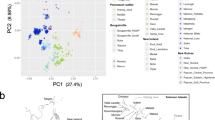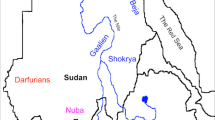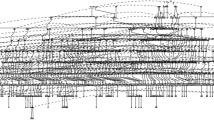Abstract
MICA is a nonclassical polymorphic MHC molecule. We investigated MICA allelic frequencies and MICA–HLA-B–HLA-C haplotypes in Brazilian Amerindians to describe the polymorphism and to extract information about the evolution of MICA gene. Kaingang is the first population described to have a high frequency of MICA*020, found associated with HLA-B*3505–HLA-Cw*0401. Allele MICA*020 probably originated de novo in South America. The Guarani population had high frequencies of MICA*027. Allele MICA*00801 is common worldwide but rare among Amerindians, occurring only because of gene flow. The analysis of the 64 described MICA alleles revealed that in exons 2 and 4, synonymous substitutions are in excess, a result compatible with purifying selection. The opposite was observed for exons 3 and 6 and the excess of nonsynonymous substitutions was significant for exon 3, indicating positive selection. Few of the alleles described so far had exon 6 sequenced, impeding conclusions for the corresponding portion of the molecule. The analysis of the entire gene is required for a better understanding of the evolution of MICA's polymorphism and its functional consequences. This knowledge is of prime importance in view of the increasing awareness of the functional and medical implications of MICA gene variability.
This is a preview of subscription content, access via your institution
Access options
Subscribe to this journal
Receive 6 digital issues and online access to articles
$119.00 per year
only $19.83 per issue
Buy this article
- Purchase on Springer Link
- Instant access to full article PDF
Prices may be subject to local taxes which are calculated during checkout


Similar content being viewed by others
References
The MHC sequencing consortium. Complete sequence and gene map of a human major histocompatibility complex. Nature 1999; 401: 921–923.
Bahram S, Spies T . The MIC gene family. Res Immunol 1996; 147: 328–333.
Bahram S, Bresnahan M, Geraghty DE, Spies T . A second lineage of mammalian major histocompatibility complex class I genes. Proc Natl Acad Sci USA 1994; 91: 6259–6263.
Collins RW . Human MHC class I chain related (MIC) genes: their biological function and relevance to disease and transplantation. Eur J Immunogenet 2004; 31: 105–114.
Schrambach S, Ardizzone M, Leymarie V, Sibilia J, Bahram S . In vivo expression pattern of MICA and MICB and its relevance to auto-immunity and cancer. PLoS ONE 2007; 2: e518.
Groh V, Bahram S, Bauer S, Herman A, Beauchamp M, Spies T . Cell stress-regulated human major histocompatibility complex class I gene expressed in gastrointestinal epithelium. Proc Natl Acad Sci USA 1996; 93: 12445–12450.
Groh V, Rhinehart R, Secrist H, Bauer S, Grabstein KH, Spies T . Broad tumor-associated expression and recognition by tumor-derived gamma delta T cells of MICA and MICB. Proc Natl Acad Sci USA 1999; 96: 6879–6884.
Zwirner NW, Fuertes MB, Girart MV, Domaica CI, Rossi LE . Cytokine-driven regulation of NK cell functions in tumor immunity: role of the MICA-NKG2D system. Cytokine Growth Factor Rev 2007; 18: 159–170.
Bauer S, Groh V, Wu J, Steinle A, Phillips JH, Lanier LL et al. Activation of NK cells and T cells by NKG2D, a receptor for stress-inducible MICA. Science 1999; 285: 727–729.
Groh V, Rhinehart R, Randolph-Habecker J, Topp MS, Riddell SR, Spies T . Costimulation of CD8alphabeta T cells by NKG2D via engagement by MIC induced on virus-infected cells. Nat Immunol 2001; 2: 255–260.
Steinle A, Groh V, Spies T . Diversification, expression, and gamma delta T cell recognition of evolutionarily distant members of the MIC family of major histocompatibility complex class I-related molecules. Proc Natl Acad Sci USA 1998; 95: 12510–12515.
Steinle A, Li P, Morris DL, Groh V, Lanier LL, Strong RK et al. Interactions of human NKG2D with its ligands MICA, MICB, and homologs of the mouse RAE-1 protein family. Immunogenetics 2001; 53: 279–287.
Li Z, Groh V, Strong RK, Spies T . A single amino acid substitution causes loss of expression of a MICA allele. Immunogenetics 2000; 51: 246–248.
Mizuki N, Ota M, Kimura M, Ohno S, Ando H, Katsuyama Y et al. Triplet repeat polymorphism in the transmembrane region of the MICA gene: a strong association of six GCT repetitions with Behçet disease. Proc Natl Acad Sci USA 1997; 94: 1298–1303.
Suemizu H, Radosavljevic M, Kimura M, Sadahiro S, Yoshimura S, Bahram S et al. A basolateral sorting motif in the MICA cytoplasmic tail. Proc Natl Acad Sci USA 2002; 99: 2971–2976.
Rueda B, Pascual M, Lopez-Nevot MA, Gonzalez E, Martin J . A new allele within the transmembrane region of the human MICA gene with seven GCT repeats. Tissue Antigens 2002; 60: 526–528.
Pérez-Rodríguez M, Corell A, Argüello JR, Cox ST, McWhinnie A, Marsh SGE et al. A new MICA allele with ten alanine residues in the exon 5 microsatellite. Tissue Antigens 2000; 55: 162–165.
Tian W, Zeng XM, Li LX, Jin HK, Luo QZ, Wang F et al. Gender-specific associations between MICA-STR and nasopharyngeal carcinoma in a southern Chinese Han population. Immunogenetics 2006; 58: 113–121.
Obuchi N, Takahashi M, Nouchi T, Satoh M, Arimura T, Ueda K et al. Identification of MICA alleles with a long Leu-repeat in the transmembrane region and no cytoplasmic tail due to a frameshift-deletion in exon 4. Tissue Antigens 2001; 57: 520–535.
Komatsu-Wakui M, Tokunaga K, Ishikawa Y, Kashiwase K, Moriyama S, Tsuchiya N et al. MIC-A polymorphism in Japanese and a MIC-A-MIC-B null haplotype. Immunogenetics 1999; 49: 620–628.
Komatsu-Wakui M, Tokunaga K, Ishikawa Y, Leelayuwat C, Kashiwase K, Tanaka H et al. Wide distribution of the MICA-MICB null haplotype in East Asians. Tissue Antigens 2001; 57: 1–8.
Aida K, Russomando G, Kikuchi M, Candia N, Franco L, Almiron M et al. High frequency of MIC null haplotype (HLA-B48-MICA-del-MICB*0107 N) in the Angaite Amerindian community in Paraguay. Immunogenetics 2002; 54: 439–441.
Frigoul A, Lefranc MP . MICA: standardized IMGT allele nomenclature, polymorphisms and diseases. Recent Res Dev Hum Genet 2005; 3: 95–145.
Belich MP, Madrigal JA, Hildebrand WH, Zemmour J, Williams RC, Luz R et al. Unusual HLA-B alleles in two tribes of Brazilian Indians. Nature 1992; 357: 326–329.
Tsuneto LT, Probst CM, Hutz MH, Salzano FM, Rodriguez-Delfin LA, Zago MA et al. HLA class II diversity in seven Amerindian populations. Clues about the origins of the Aché. Tissue Antigens 2003; 62: 512–526.
Petzl-Erler ML, Luz R, Sotomaior VS . The HLA polymorphism of two distinctive South-American Indian tribes: the Kaingang and the Guarani. Tissue Antigens 1993; 41: 227–237.
Zhang Y, Lazaro AM, Zou Y, Lavignia B, Moraes EM, Moraes RJ et al. MICA polymorphism in South American Indians. Immunogenetics 2002; 53: 900–906.
Katsuyama Y, Ota M, Ando H, Saito S, Mizuki N, Kera J et al. Sequencing based typing for genetic polymorphisms in exons, 2, 3 and 4 of the MICA gene. Tissue Antigens 1999; 54: 178–184.
Pyo CW, Hur SS, Kim YK, Choi HB, Kim TY, Kim TG . Distribution of MICA alleles and haplotypes associated with HLA in the Korean population. Hum Immunol 2003; 64: 378–384.
Romphruk AV, Naruse TK, Romphruk A, Kawata H, Puapairoj C, Kulski JK et al. Diversity of MICA (PERB11.1) and HLA haplotypes in Northeastern Thais. Tissue Antigens 2001; 58: 83–89.
Rees MT, Downing J, Darke C . A typing system for the major histocompatibility complex class I chain related genes A and B using polymerase chain reaction with sequence-specific primers. Genet Test 2005; 9: 93–110.
Gao X, Single RM, Karacki P, Marti D, O′Brien SJ, Carrington M . Diversity of MICA and linkage disequilibrium with HLA-B in two North American populations. Hum Immunol 2006; 67: 152–158.
Petersdorf EW, Shuler KB, Longton GM, Spies T, Hansen JA . Population study of allelic diversity in the human MHC class I-related MIC-A gene. Immunogenetics 1999; 49: 605–612.
Zhang Y, Han M, Vorhaben R, Giang C, Lavingia B, Stastny P . Study of MICA alleles in 201 African Americans by multiplexed single nucleotide extension (MSNE) typing. Hum Immunol 2003; 64: 130–136.
Piancatelli D, Del Beato T, Oumhani K, El Aouad R, Adorno D . MICA polymorphism in a population from north Morocco, Metalsa Berbers, using sequence-based typing. Hum Immunol 2005; 66: 931–936.
Parham P, Arnett KL, Adams EJ, Little AM, Tees K, Barber LD et al. Episodic evolution and turnover of HLA-B in the indigenous human populations of the Americas. Tissue Antigens 1997; 50: 219–232.
Ellegren H . Microsatellites: simple sequences with complex evolution. Nat Rev Genet 2004; 5: 435–445.
Chalupny NJ, Rein-Weston A, Dosch S, Cosman D . Down-regulation of the NKG2D ligand MICA by the human cytomegalovirus glycoprotein UL142. Biochem Biophys Res Commun 2006; 346: 175–181.
Choy MK, Phipps ME . Possible polyphyletic origin of major histocompatibility complex class I chain-related gene A (MICA) alleles. J Mol Evol 2003; 57: 38–43.
Martinez-Naves E, Barber LD, Madrigal JA, Vullo CM, Clayberger C, Lyu SC et al. Interactions of HLA-B*4801 with peptide and CD8. Tissue Antigens 1997; 50: 258–264.
Elsner HA, Schroeder M, Blasczyc R . The nucleotide diversity of MICA and MICB suggests the effect of overdominant selection. Tissue Antigens 2001; 58: 419–421.
Ohashi J, Tokunaga T . Computer simulation analysis suggests weak balancing selection operative at the MICA locus. Hereditas 2000; 133: 25–28.
Petzl-Erler ML, McDevitt HO . Molecular analysis of the HLA-DRB genes in two tribes of Brazilian Indians. Hum Immunol 1994; 41: 180–184.
Ota M, Katsuyama Y, Mizuki N, Ando H, Furihata K, Ono S et al. Trinucleotide repeat polymorphism within exon 5 of the MICA gene (MHC class I chain-related gene A): allele frequency data in the nine population groups Japanese, Northern Han, Hui, Uygur, Kazakhstan, Iranian, Saudi, Arabian, Greek and Italian. Tissue Antigens 1997; 49: 448–454.
Collins RW, Stephens HA, Clare MA, Vaughan RW . High resolution molecular phototyping of MICA and MICB alleles using sequence specific primers. Hum Immunol 2002; 63: 783–794.
Excoffier L, Laval G, Schneider S . Arlequin ver. 3.0: An integrated software package for population genetics data analysis. Evol Bioinform Online 2005; 1: 47–50.
Cavalli-Sforza LL, Edwards AWF . Phylogenetic analysis: models and estimation procedures. Evolution 1967; 32: 550–570.
Fitch WM, Margoliash E . Construction of phylogenetic trees. Science 1967; 155: 279–284.
Felsenstein J . PHYLIP (Phylogeny Inference Package). version 3.6. Distributed by the author Department of Genome Sciences, University of Washington: Seattle, 2004.
Page RDM . TREEVIEW: An application to display phylogenetic trees on personal computers. Comput Appl Biosci 1996; 12: 357–358.
Rozas J, Sánchez-DelBarrio JC, Messeguer X, Rozas R . DnaSP, DNA polymorphism analyses by the coalescent and other methods. Bioinformatics 2003; 19: 2496–2497.
Tamura K, Dudley J, Nei M, Kumar S . MEGA4: Molecular Evolutionary Genetics Analysis (MEGA) software version 4.0. Mol Biol Evol 2007; 24: 1596–1599.
Acknowledgements
We thank the individuals of the populations analyzed in this research for their collaboration. The support and friendship of our laboratory colleagues are highly valued. We are also grateful for the support of Conselho Nacional de Desenvolvimento Científico e Tecnológico (CNPq), Institutos do Milênio, Fundação Araucária de Apoio ao Desenvolvimento Científico e Tecnológico do Paraná, Fundação da Universidade Federal do Paraná (FUNPAR) and Coordenação de Aperfeiçoamento de Pessoal de Nível Superior (CAPES).
Author information
Authors and Affiliations
Corresponding author
Rights and permissions
About this article
Cite this article
Oliveira, L., Ribas, F., Bicalho, M. et al. High frequencies of alleles MICA*020 and MICA*027 in Amerindians and evidence of positive selection on exon 3. Genes Immun 9, 697–705 (2008). https://doi.org/10.1038/gene.2008.65
Received:
Revised:
Accepted:
Published:
Issue Date:
DOI: https://doi.org/10.1038/gene.2008.65



